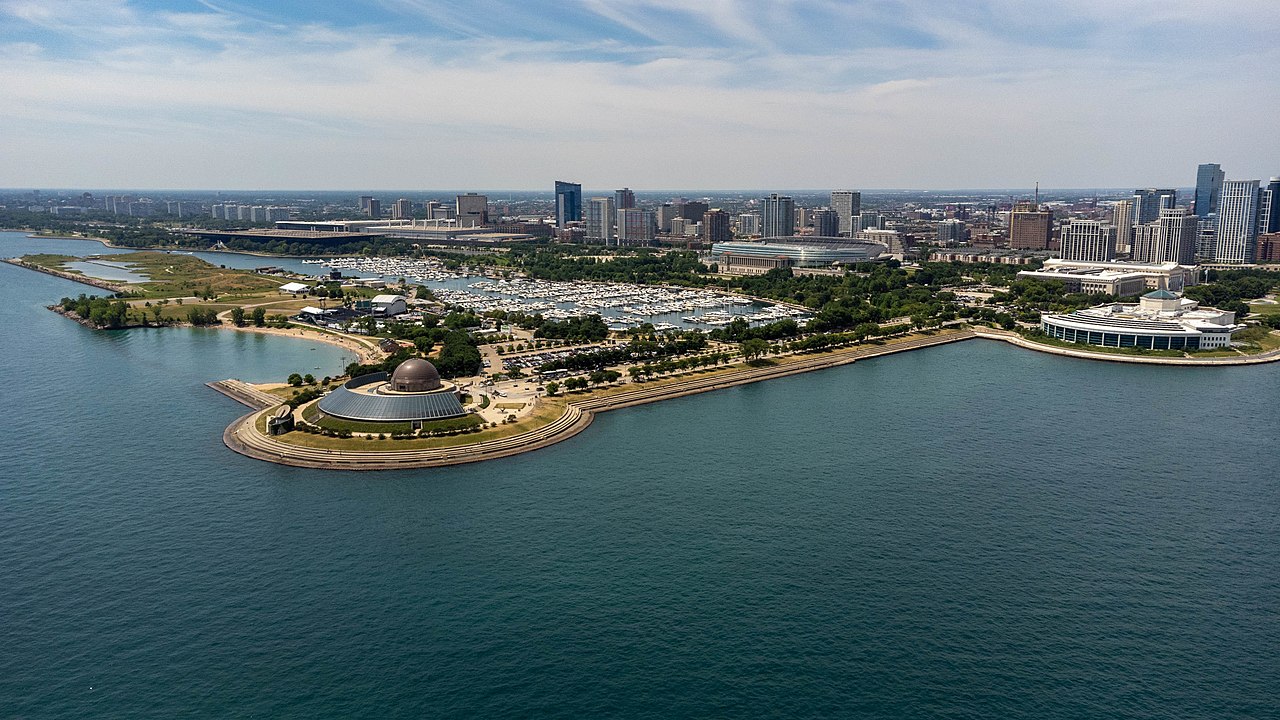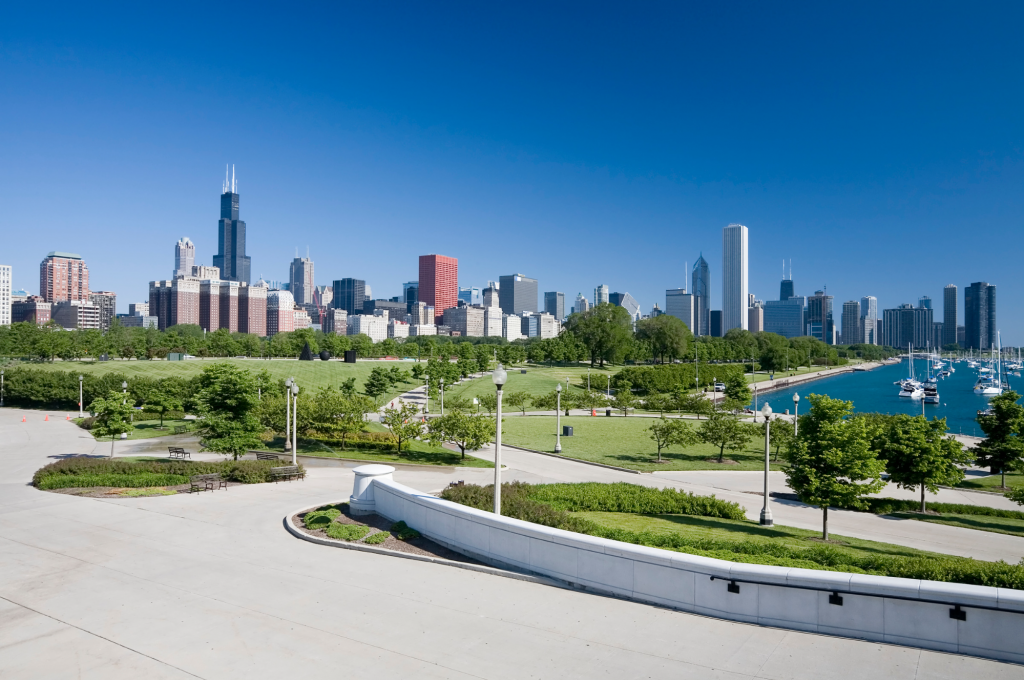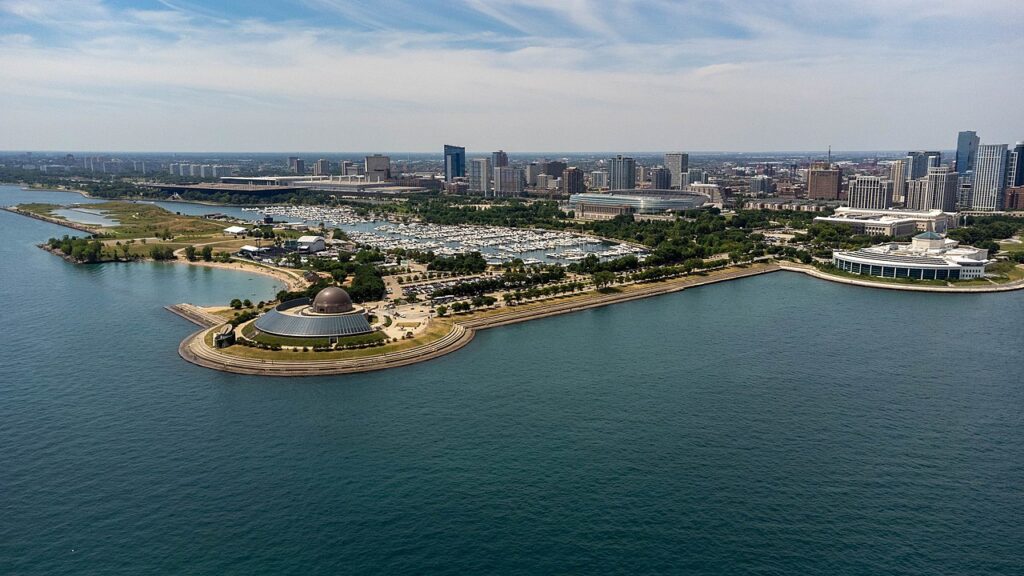
Iconic Chicago: The Museum Campus
Published on April 12, 2023
Consisting of the Field Museum of Natural History, Shedd Aquarium, and Adler Planetarium, the Museum Campus offers interactive, educational exhibits in one of the most picturesque spots in Chicago. Next time you visit, check out eATLAS’ scavenger hunt of the public art on display.
By Dave Lifton (@daveeatschicago)
A world-class city needs world-class museums, and Chicago has three all within walking distance of each other in a section of Grant Park known as the Museum Campus.
The Field Museum arrived first, but not in the current location. During the planning for the World’s Columbian Exhibition in 1893, it was suggested that artifacts from the fair be housed permanently. Thanks to a $1 million donation from Marshall Field, the Field Columbian Museum opened in what had been the Palace of Fine Arts, and is now the Museum of Science and Industry, on June 2nd, 1894.
By 1905, the museum included natural sciences, and the name was changed to Field Museum of Natural History. Field died a year later, and his will endowed the museum with $4 million to build a new home. In the 1909 Plan of Chicago, Daniel Burnham proposed the location where the Buckingham Fountain sits today, but Aaron Montgomery Ward successfully sued to block its creation. Instead, undeveloped land south of 12th St. (Roosevelt Road) was chosen, and construction began in 1915.

The new building opened on May 2nd, 1921, and has since averaged 1.37 million visitors a year. Its permanent exhibitions include the Grainger Hall of Gems, Robert R. McCormick Halls of the Ancient Americas, Inside Ancient Egypt, Cyrus Tang Hall of China, and a 3D movie theater. But the Field Museum’s best-known attraction is Sue, a 40-foot long, 67 million-year-old Tyrannosaurus rex skeleton that has been on display since 2000.
The Shedd Aquarium and Adler Planetarium opened within a few weeks of each other in May 1930. Gifted to the city by John G. Shedd, who became president of Marshall Field & Co. after its namesake’s death, the aquarium annually receives nearly 2 million guests, who delight in their ability to see marine life from all over the world—including the Amazon, Caribbean, and the North and South Poles—up close. It has been expanded twice; the Abbott Oceanarium was built in 1991, and the Wild Reef arrived in 2003.
After visiting Munich’s planetarium in 1928, Max Adler, a former vice president with Sears, Roebuck & Co., decided to fund the first of its kind in the Americas. The spot chosen was the northern tip of the newly created Northerly Island, and the “classroom under the heavens” opened on Adler’s birthday, May 12th, 1930. The more-than 500,000 annual visitors take in shows at the Grainger Sky Theater; and learn about the past, present, and future of astronomy and space exploration in its exhibits.
All three museums were integral to the Century of Progress, Chicago’s second World’s Fair that was held along the lakefront and Northerly Island from 1933-34. But a different definition of progress would soon affect the buildings. The southern expansion of Lake Shore Drive routed the northbound lanes east of the Field Museum and Soldier Field and the southbound lanes running to the west. Although it provided awe-inspiring views of the Field Museum for motorists, the new road affected pedestrian access to all three buildings.

In the early 1980s, the idea of uniting the museums was proposed as part of Chicago’s plan to host the 1992 World’s Fair. Although the event was ultimately canceled, the decision to re-route the northbound lanes to west of the Field Museum was eventually approved. Construction began in 1994 and took two years. The city spent another year and a half landscaping the grounds, and the newly christened 57-acre Museum Campus was completed in July 1998 at a cost of $110 million.
The Museum Campus was made even more pedestrian-friendly in 2003, when Mayor Richard M. Daley controversially closed Meigs Field, an airport that had been on Northerly Island, south of the Adler Planetarium, since 1948. The land has since been turned into a 91-acre park and nature preserve designed by Studio Gang.
Over the years, the grounds have become a home for public art from around the world. Combined with fascinating exhibits from a broad range of subjects and some of the best views of Chicago’s incredible skyline, the Museum Campus has become one of the city’s most beloved attractions.

The Adventure starts when you say it does.
All eATLAS Adventures are designed and built by experienced eATLAS Whoa!Guides. They're always on. Always entertaining. And always ready to go.
Check out our Adventures!